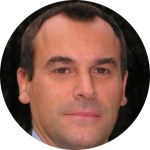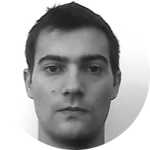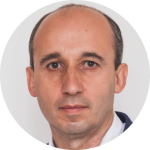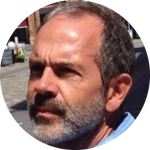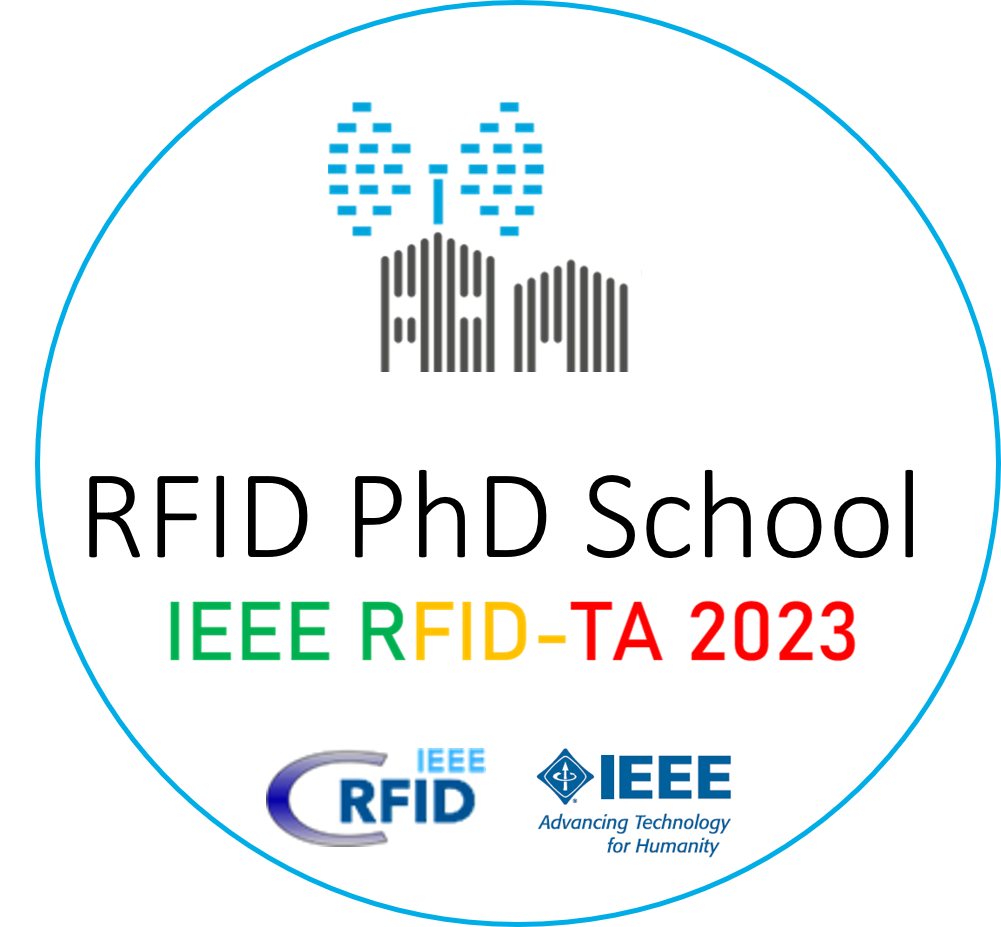
Sunday, 3rd September 2023
INVITED RFID PhD School SPEAKERS
UHF-RFID technology for the development of effective and low-cost radio localization systems
Abstract
UHF-RFID technology is largely used for the automated and remote identification of persons, tools and products, through radio waves in the 860-960 MHz frequency band. In the last decade, off-the-shelf UHF-RFID readers and tags are being also used to locate assets inside indoor scenarios, products in warehouses, medicine boxes inside drawers and books on shelves. This course is aimed at presenting those techniques that can be used to process amplitude and phase of the tag backscattered signals, to get an estimate of the tag/reader relative position. Several examples and data relevant to realistic experimental campaigns and different application scenarios will be shown. As a concluding remark, limits and open problems of the RFID-based localization solutions will be discussed.
Bio
Paolo Nepa (Senior Member, IEEE) received the Laurea degree (summa cum laude) in electronics engineering from the University of Pisa, Pisa, Italy, in 1990. Since 1990, he has been with the Department of Information Engineering, University of Pisa, where he is currently a Full Professor. His research interests include the design of wideband and multiband antennas for mobile communication systems, as well as in the design of antennas optimized for near-field coupling and focusing. He was working on channel characterization, wearable antenna design, and diversity scheme implementation, for body-centric communication systems. In the context of UHF-RFID systems, he is working on efficient techniques for radio localization of either tagged objects or mobile readers, in the context of Internet of Things (IoT) and smart industry scenarios. He has co-authored more than 300 international journal articles and conference contributions. Prof. Nepa served as a TPC member for several international IEEE conferences. Since 2013, he has been a member of the Technical Advisory Board of URSI Commission B—Fields and Waves. In 2019, he was the General Chair of the IEEE RFID-TA 2019 International Conference. Since January 2023 he is serving as Editor in Chief of the journal IEEE Journal of Radio Frequency Identification. Since 2021 he is serving as Associate Editor of IEEE Transactions on Antennas and Propagation. From October 2016 till 2022 he served as Associate Editor of IEEE Antennas and Wireless Propagation Letters, and he was a recipient of the Outstanding Associate Editors Award in 2021.
Techniques for passive generation of UWB pulses
Abstract
This lecture discusses hardware and software techniques to exploit the energy harvesting sub-system of RFID tags, when excited by multi-sine signals, as a passive UWB pulse generator. In such conditions it is possible to generate UWB pulses, by harvesting the intermodulation (IM) products of the excitations, for localization purposes. This is accomplished by designing a modified rectifier with two output ports: one for dc power harvesting and one for IM products harvesting to be re-radiated by a suitable UWB antenna. The optimization procedure for choosing the best multi-sine excitation signals, their frequency spacing and bandwidth, is presented. A system-level localization procedure is then discussed.
Bio
Measuring modulated backscattered signals
Abstract
Hardware tag characterization is one of the most critical steps in RFID and zeropower IoT development flow. However, the measurement process and its respective setup can be long and cumbersome. This paper describes how to use basic but uncharted VNA modes to yield simple, fast and flexible measurements without any spectrum analyser, SDR, oscilloscope, or anechoic chamber. The VNA allows to estimate both magnitude and phase of frequency components around the illuminating carrier frequency (i.e. the intermodulations) backscattered by the transponder. It can also measure the modulated backscattered power as a function of the carrier frequency. These modes of operation can eventually be used to realize both identification and sensing of linear time-variant (LTV) transponders at a significant range.
Bio
Simon Hemour (Senior Member, IEEE) received the B.S. degree in electrical engineering from the University of Grenoble Alpes, Grenoble, France, in 2004, and the M.S. and Ph.D. degrees in optics, optoelectronics, and microwave engineering from the Grenoble Institute of Technology, Grenoble, in 2006 and 2010, respectively.,In 2003, he was with the European Organization for Nuclear Research, Geneva, Switzerland, as a member of the Instrumentation Department, where he was involved in the ATLAS experiment on the Large Hadron Collider. From 2006 to 2007, he was a Research Assistant with the Pidstryhach Institute of Applied Problems of Mechanics and Mathematics, National Academy of Science of Ukraine, Lviv, Ukraine. In 2007, he joined the IMEP-LAHC MINATEC Laboratory, Grenoble. From 2011 to 2015, he was with the Poly-Grames Research Center, École Polytechnique de Montréal, Montreal, QC, Canada, where he was coordinating the Wireless Power Transmission and Harvesting Research Group. He joined the Université de Bordeaux, Bordeaux, France, in 2015, where he is currently an Associate Professor and he leads research in wireless micro-energy solutions for the Internet-of-Things (IoT) and biomedical applications. His current research interests include wireless power transfer and hybrid energy harvesting, backscattering, nonlinear and negative resistance devices, innovative radio frequency (RF) measurements, RF interferometry, low-power microwave, and millimeter-wave conversion circuits, and development of RF transponders and sensors for wireless systems and biomedical applications. Dr. Hemour is a member of the IEEE MTT-25 Wireless Energy Transfer and Conversion Technical Committee. He was the TPC Chair of the 2018 Wireless Power Transfer Conference (WPTC), the TPC co-chair of 2023 RFID-TA and the General Chair of the 2022 WPTC. He has served as a Guest Editor for IEEE Transactions on Microwave Theory and Techniques and IEEE Journal of Electromagnetics, RF and Microwaves in Medicine and Biology.
Software Defined Radio for UHF RFID technology
Abstract
In this presentation, we introduce a simple low-cost SDR RFID UHF reader capable of reading a tag in real time. This reader is designed around a simple asynchronous OOK modulator in transmission and an envelope detector in reception. All tasks specific to the RFID protocol including clock recovery, data recovery and frame detection are handled in software by a Arduino Uno micro-controller. This reader is able to generate any RFID command supported by the protocol and to decode any message backscattered by the tag in real time. We also present a simple open-source software-defined based UHF (RAIN) RFID tag that can be used for academic research. The hardware associated with this tag is only composed of an envelope detector and an RF switch and uses a modular design. All operations related to the RFID protocol are entirely realized in software and can be processed by an Arduino Uno platform. The purpose of this work is to encourage researchers and students to experiment with RAIN RFID technology, to understand its protocols and standards, and to improve the proposed reader and tag design. All relevant files (including schematic and source code) are released as open source to the community.
Bio
Nicolas Barbot received the M.Sc. degree and Ph.D. degree from the University de Limoges, France in 2010 and 2013 respectively. His Ph.D. work in Xlim Laboratory was focused on error-correcting codes for the optical wireless channel. He also completed a postdoctoral work in joint source-channel decoding at L2S Laboratory, in Gif-sur-Yvette, France. Since September 2014, he has been an Assistant Professor at the Université Grenoble Alpes – Grenoble Institute of Technology, in Valence, France. His scientific background at LCIS Laboratory covers wireless communications systems based on backscattering principle which include classical RFID and chipless RFID. His research interests include transponders which can not be described by linear time-invariant systems. This gathers harmonic transponders which are based on the use of a non-linear component (Schottky diode) or linear time-variant transponders which are based on the modification of their response in the time domain. He also places special interests on antenna design and instrumentation based on these phenomena.
All-digital and low cost SDR backscatter transceivers
Abstract
In this talk the use of low-cost Software Defined Radio Solutions and All digital Radios for the implementation of a pure backscatter radio transceiver will be presented and discussed. The use of higher order modulations combined with simplistic SDR solutions will be carefully discussed and further explored by presenting some practical applications of such a radio solution in a smart city environment.
Bio
Arnaldo S. R. Oliveira received the B.Sc. and M.Sc. degrees in electronics and telecommunications and, in 2007, the Ph.D. degree in electrical engineering from the University of Aveiro, Portugal. He is currently a Researcher at the Telecommunications Institute, University of Aveiro. Since 2001, he has taught computer architecture, digital systems design, programming languages, and embedded systems at the University of Aveiro. He participates in several national and international funded research projects. He is the author or co-author of more than 130 journal and international conference papers. His research interests include reconfigurable digital systems, software-defined radio, and next-generation radio access networks.
Location, location, location” in 2023: RFID for mobile robot localization and navigation
Abstract
Localization and navigation of mobile robots is crucial for implementing autonomous robotic systems. Several technologies have been explored with advantages and disadvantages to perform this operation. RFID technology has recently been considered due to its low cost and practicality, giving rise to a new line of research. By exploiting the probability of detection, the received signal strength, or the phase of the tag backscattered signal, it is possible to get vehicle location information. RFID technology shows pros and cons, and several precautions must be considered for real-system deployment. This talk aims to give an overview of the advantages and challenges that RFID technology has to face to be used on a large scale in mobile–robotics applications. Within the talk, a self-locating robot for item inventory and localization is presented. This is one of the first complete RFID-based robots for store management presented in the literature, which paves the way for a new generation of autonomous robots based on low-cost backscattering communications.
Bio
Andrea Motroni (S’17, M’20) received the M.E. (with honors) degree in Telecommunication Engineering and the Ph.D. (with honors) degree in Information Engineering from the University of Pisa, Pisa, Italy, in 2017 and 2021, respectively, where he is currently an Assistant Professor in Applied Electromagnetics. In 2019, he was the President of the IEEE Student Branch of the University of Pisa. In 2020, he was a Visiting Ph.D. Student with the Graz University of Technology, Graz, Austria. He has joined the Organizing Committee and has been Session Chair of several IEEE international conferences. Dr. Motroni was a Finalist at the IEEE CRFID Educational Mega Challenge (2018), a recipient of the Best Paper Award and Best Student Paper Award at IEEE RFID-TA 2019, and a recipient of the Young Scientist Award from the International Union of Radio Science, Commission B, in 2021 and 2023. In 2022, Dr. Motroni was awarded the IEEE/ABB Italy Section award for a Ph.D. Thesis, with the “2021 Best Ph.D. Dissertation in the field of Information and Industrial Engineering” from the University of Pisa and the “Best Poster Award” at IEEE M&N 2022. His current research interests include indoor radio localization systems, with a specific focus on UHF-RFID and UWB technology for robot and vehicle localization, the integration of robotic systems with RFID towards new systems for industry and logistics, UHF-RFID smart gates and other RFID-based applications for Internet of Things, Industry 4.0, and people safety in both indoor and outdoor environments.
Smart radiating architectures for energy-aware wireless power transfer
Abstract
In wireless power transfer (WPT) applications the weakest contribution to the overall link efficiency is the effective selection of the zone to be powered. Hence, the need for smart transmitting architectures is strong. In this talk, two promising families of highly-reconfigurable arrays are presented: first, time-modulated arrays (TMAs) are considered as a powerful tool for selective WPT, through their peculiar sideband radiation phenomenon; frequency-diverse arrays (FDAs) are, then, proposed as a smarter solution, able to focus the beam in range, too, thus avoiding the illumination of unwanted targets
Bio
Diego Masotti (M’00, SM’16) received the Ph.D. degree in electric engineering from the University of Bologna, Italy, in 1997. In 1998 he joined the University of Bologna where he now serves as an Associate Professor of electromagnetic fields. From 2021 he has the role of coordinator of the Telecommunications Engineering Master Degree course. His research interests are in the areas of nonlinear microwave circuit simulation and design, with emphasis on nonlinear/electromagnetic co-design of integrated radiating subsystems/systems for wireless power transfer and energy harvesting applications. He authored more than 70 scientific publications on peer reviewed international journals and more than 170 scientific publications on proceedings of international conferences. Dr. Masotti serves in the Editorial Board of Electronic Letters, of the Hindawi journal of Wireless Power Transfer, of IEEE Access, and is a member of the Paper Review Board of the main Journals of the microwave sector.
Chipless Radio Frequency Identification (RFID) Technology: basics and future challenges
Abstract
Chipless RFID is an emerging technology aimed at embedding a code or some information within the signal backscattered by a passive resonator when interrogated with radio frequency EM wave. Differently from classical Radio Frequency Identification (RFID), the coding in chipless RFID tags is carried out directly by the antenna or the resonant scatterers that performs the data processing at the physical level. This means that chipless RFID technology is more prone to environmental disturbs which represents the most important challenge for the technology. Other challenges are represented by the compatibility with low-cost production processes and the availability of low-cost and portable reader solutions. On the other hand, chipless RFID technology has large potentialities since it could benefit from easy integration on products, low-production cost, frequency scalability and offers a sustainable solution for delivering biocompatible sensors and authentication devices. The indirect measurement of several environmental quantities, or mechanical changes, extracted from the measured backscattering spectrum has been demonstrated at a laboratory level and a future challenge consists in testing these solutions in realistic operating scenarios.
Bio
Filippo Costa (Senior Member, IEEE) received the M.Sc. degree in telecommunication engineering and the Ph.D. degree in applied electromagnetism from the University of Pisa, Pisa, Italy, in 2006 and 2010, respectively. In 2009, he was a Visiting Researcher with the Department of Radio Science and Engineering, Aalto University, Espoo, Finland. From 2015 to 2017, he was a Short-Term Visiting Researcher with the Grenoble Institute of Technology, Valance, France, and University Rovira I Virgili, Tarragona, Spain. He is currently with the University of Pisa. His current research interests include metamaterials, metasurfaces, antennas, and radio frequency identification. He has coauthored more than 200 international journal articles and conference contributions collecting more than 6500 citations. He was selected among the outstanding reviewers of the IEEE TRANSACTIONS ON ANTENNAS AND PROPAGATION (2015-2021) and the IEEE ANTENNAS AND WIRELESS PROPAGATION LETTERS (2017,2018). He was recipient of the Young Scientist Award of the URSI International Symposium on Electromagnetic Theory, URSI General Assembly and URSI AT-RASC in 2013, 2014 and 2015, respectively. Dr. Costa serves as an Associate Editor for IEEE TRANSACTIONS ON ANTENNAS AND PROPAGATION, IEEE ANTENNAS AND WIRELESS PROPAGATION LETTERS, IEEE SENSORS LETTERS, Scientific Reports, Sensors and Electronics.

